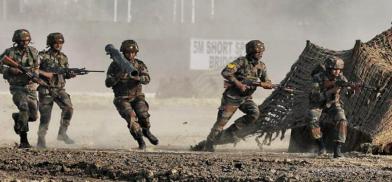Lucknow DefExpo showcased India as defence exporter
Inaugurating the 11th and largest ever Indian defence exposition, DefExpo, organised from February 5–9 in Lucknow, Prime Minister Narendra Modi announced a target of USD$5 billion for defence exports, to be achieved over the next few years, and added that India, a democracy with a huge population, cannot remain long dependent on defence imports. India currently imports about 70% of its defence needs.

Inaugurating the 11th and largest ever Indian defence exposition, DefExpo, organised from February 5–9 in Lucknow, Prime Minister Narendra Modi announced a target of USD$5 billion for defence exports, to be achieved over the next few years, and added that India, a democracy with a huge population, cannot remain long dependent on defence imports. India currently imports about 70% of its defence needs.
With 1028 companies, including 172 foreign companies, participating and defence ministers and armed forces chiefs from 38 countries taking part in DefExpo, along with a wide array of arms and equipment, including those produced in India, showcased, the stage was set to present India as a net exporter of defence equipment. This could change India’s status as the second-largest importer of defence equipment, just behind Saudi Arabia in 2019 (according to the Stockholm International Peace Research Institute).
India is now set to export arms and defence equipment to about 42 countries including the US, Australia, Finland, France, Germany, Israel, South Africa, Sweden, Azerbaijan, Seychelles, Estonia, Indonesia, Guinea, the Philippines, Qatar, Lebanon, Iraq, Ecuador, Uruguay, Japan and Egypt. Indian defence product exports to Australia include 5.56x45mm Ball MK N(SS109) cartridges, while it exported protective headgear and hard armour plates to Azerbaijan, helmets, bomb suppression blankets and soft armour panels to Germany, sleeping bags to Guinea, mortar shell covers to Israel, hard armour plates to the Netherlands and the US, radar parts, bullet proof vests and helmets with accessories to Singapore, detonators to South Africa and night vision binoculars to Thailand.
At a ceremony on February 7, 13 products including the India-made Light Utility Helicopter (LUH) manufactured by Hindustan Aeronautics Limited (HAL) and Sharang 155 mm artillery gun made by the Ordnance Factory Board (OFB), among others, were showcased.
A major announcement during DefExpo 2020 was the issuance of the Initial Operational Clearance (IOC) certificate for the LUH was issued to HAL. The LUH was designed and developed as a replacement for Cheetah and Chetak helicopters which have been operated by Indian Armed forces for decades beyond their manufacturers’ expectations/parameters. LUH is a new generation helicopter in the 3-Ton class incorporating state-of-the-art technology features which will meet the emerging needs in this class of helicopters in the coming decades.
The handing over of a model of OFB’s 155 mm artillery gun ‘Sharang’, with a range of 36 km, to Army Chief General M M Naravane was significant, as the Artillery branch has been short of guns for far too long. Bharat Dynamics Limited (BDL) launched the Amogha-3 anti-tank guided missile, portable and the fire and forget type. BDL has also launched ‘Varunastra’ – the anti-submarine torpedo, manufactured under the technological guidance of DRDO.
More than 22 seminars held over four days during the DefExpo highlighted the technological changes, digital transformation of defence and positive policies implemented by the government, including relaxation of rules in FDI investment, encouraging innovation in Defence start-ups, opening testing facilities to the private sector and sharing technological innovations by the Defence Research and Development Organisation (DRDO), to make India a defence manufacturing hub.
More than 120 MoUs were signed between defence public sector undertakings (DPSUs), and private and global defence manufacturing companies, including 23 by the Uttar Pradesh Government. These MoUs envisage an investment of INR 500 billion in the defence corridor setup in the state and generating 300,000 job opportunities.
Among other DefExpo highlights was the India pavilion which offered a peep into futuristic technologies such as Artificial Intelligence (AI), Augmented Virtual Reality (AVR), Autonomous Systems, Internet of Military Things (IoMT) and Industry 4.0. DRDO handed over 15 licenses for Transfer of Technology (ToT) to 17 industries on technologies developed by it.
DefExpo 2020 offered a unique opportunity for the Indian DPSUs to showcase their technological innovations and new products to the world.
Live demonstrations by the Indian Army and Indian Air Force at the DefExpo site, the Indian Navy and Indian Coast Guard’s live performances at the Gomti riverfront and demonstrations by DRDO enthralled the audiences.
Indian Army daredevils on their motorcycles, a flypast by Surya Kiran jets, commandos climbing down ropes hanging from helicopters, horse riding and so on were a great hit with everyone present, while the technical demos may generate more orders.
(The writer is a former Defence Ministry and Indian Army spokesperson)










Post a Comment